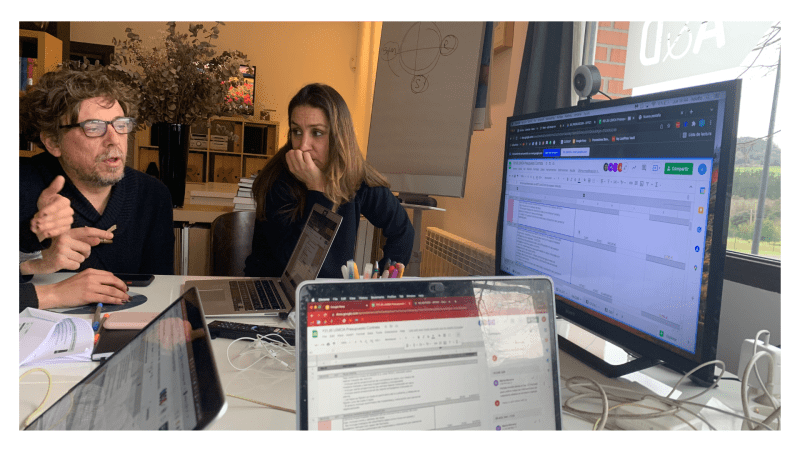Running an architecture firm without goals
As an architecture student, I decided to create my architectural firm.
This jump was scary because I had no idea how to run a business.
It was like walking into a dark room, not knowing what to expect.
I knew something about architecture but very little about business management.
At the beginning, everything was chaos.
I was working all the time, trying to make things work.
But I hardly had any tangible results. I felt like I was running in circles.
And I made all kinds of mistakes that would cost me dearly.
This was normal. We didn’t learn about business in architecture school.
And I’m not going to lie; it was a tough time.
.

.
Then I realized my mistake.
I was working hard but without a clear plan, doing things without knowing why I was doing them.
I needed goals to guide me, to show me the way.
Luckily, a mentor guided me and made this process much easier.
.
So I sat down and thought long and hard about what I wanted to achieve at work and in life.
Setting those goals changed the rules of the game.
I started working smarter, not just harder.
I started paying attention to both goals and details.
.
And I learned something important:
It’s not just about making money or winning projects.
It’s about finding a balance, enjoying work, and having time for myself and my family.
.
This is my story, from being a disorganized architect to becoming a serial entrepreneur.
I hope my journey inspires you as you start your own.
.

.
The Importance of Goals for Your Business
When you start your own architecture firm, having goals is a must.
It shows you where to go and keeps you on track.
Think about building a house.
You wouldn’t start without a plan, right? Because everything can go wrong, you know that.
The same goes for your business.
.
Goals are important because they give you something to aim for.
👉 They help you focus and make decisions.
When you know what your goal is, you can ask yourself,
“Will this help me get more clients?”
“Will this help me get to work less hours?”
“And will this help me have more time with my family?”
If the answer is no, you may not need to do it.
.
But how do you set these goals for your architecture firm?
Well, the easy way is to define your SMART Goals.
SMART stands for Specific, Measurable, Achievable, Relevant, and Time-bound.
Let’s break this down with examples to make it crystal clear.
.
Specific
Your goal should be clear and specific so you know exactly what you aim for.
.
❌ Vague Goal: I want to grow my business.
✅ SMART Goal: I want to acquire 10 new clients in the architectural design sector within the next six months.
.
Measurable
Include precise amounts, dates, or other metrics to measure your progress.
This helps you know if you’re on track.
.
❌ Vague Goal: I want to make more money.
✅ SMART Goal: I want to increase my monthly revenue by 20% within the next year.
.
Achievable
Your goal should be realistic and attainable to be successful. It should stretch your abilities but still be possible.
.
❌ Vague Goal: I want to be the best architect in the world.
✅ SMART Goal: I aim to win a local architecture competition award by the end of next year.
.
Relevant
Ensure that your goal matters to you and aligns with other relevant goals.
It should be worthwhile and fit with your broader plans.
.
❌ Vague Goal: I want to do more networking.
✅ SMART Goal: I want to join two professional architect associations and attend monthly meetings to build my network in the local community.
.
Time-bound
Every goal needs a deadline, so you have a timeframe to focus on and something to work toward.
.
❌ Vague Goal: I want to finish my ongoing projects.
✅ SMART Goal: I will complete my current three architectural projects within the next four months.
.
This strategy will help you focus your efforts and use your time and resources productively.
You may be able to increase your chances of achieving what you truly want in your career and life: Freedom.
.
Remember that goals are not just about work. They’re also about your life outside of work.
Maybe you want to spend more time with your family or travel.
These personal goals are also important.
.
My advice: Stop guessing and start growing.
🎓 Tired of setting goals but never hitting them? Take control of your professional future with the Business – SMART Goals Sprint. Learn how to set achievable goals that move the needle, keep you focused, and finally get you where you want to be in your career.

.
What did I learn running an architecture firm without goals?
Now, let’s get into how you can set goals that really work for you.
Setting goals isn’t just about picking something you want to do.
👉 It’s about prioritizing what you need to do first.
Here are some practical techniques to create effective goals ↓
.
1) Start with the Big Picture
Think about what you really want in the long run.
This could be becoming a well-known architect in your field, making a certain amount of money, or having more time for personal projects.
These big dreams are your starting point.
.
My initial big goal when I started Bamboo Architecture was to be a construction company, not just a design studio.
I saw successful architects bring their best designs to reality and make a lot of money along the way.
I wanted that same thing. And 10 years later, I did it.
.

.
A couple of years later, with Stoor Architecture Marketplace, my biggest goal was to become the largest architectural project store in BIM.
The idea was to attract the greatest architectural designers to sell their best projects to thousands of clients worldwide.
We are still figuring it out but still pursuing that big goal.
.
Today, with Global Architect, our biggest goal is to impact over 50,000 architects and help them grow their architectural businesses.
That may seem like very few architects, but it’s a big number compared to all the architects in the world who are actually business-oriented (about 1%).
.
👉 So yes, dream big. As big as you can.
Time and the market will put you in your place; don’t worry.
.
2) Break it Down
Big goals can feel overwhelming.
👉 Break them down into smaller, more manageable steps.
For example, if you want to earn more money, start by setting a target for each month or each project.
.
When I started Bamboo, I had no idea about it.
For me, it was everything very simple, and I had no time to dissect my goals.
You can imagine how wrong that went…
So, my mentor showed me how to get into detail with our goals.
.
For example, instead of vaguely aiming to “earn more,” we set a clear target.
We aimed to increase revenue by 20% in six months, so we broke this down to a 3-4% increase each month.
This could mean taking on one additional small monthly project or upselling services like Interior Design or Construction on two existing projects.
That way, it was easier for us to increase our revenue.
.

.
Another example, our goal was to reduce project costs by 15%.
We broke this down by targeting specific areas like material costs, labor, or operational expenses.
For instance:
- We negotiated a 5% reduction in material costs with our suppliers.
- streamlined the design process to save 5% in labor hours
- and reduced overheads by 5% through more efficient project management
.
Today, with Global Architect, our goal is to expand the client base, so we set specific networking goals:
- Attend two industry events per month, either online or offline.
- Connect with 100 potential clients weekly on LinkedIn
- Collaborate with other influencers for referrals.
.
We measure success by the number of qualified leads generated every week.
.
In my experience, this approach makes goals more attainable and helps maintain motivation and focus.
It cultivates a systematic approach to business, encourages continual learning and adaptation, and nurtures a balanced professional life.
.
What else?
.
3) Be Specific
👉 Make your goals as clear as possible.
Instead of saying, “I want to get more clients,” say, “I want to get five new clients in the next three months.”
This makes it easier to see if you’re on track.
.
As I told you before, being specific is key to setting goals.
One thing I learned in Bamboo was being more specific with my goals.
I once set a goal to “increase revenue,” we targeted a 15% increase in project value from existing clients within six months.
.
This required me to think creatively about offering additional services and renegotiating ongoing contracts, which was a successful strategy.
.
This is how I did it:
1 – I began by thoroughly reviewing my current client portfolio to understand the scope of ongoing projects and identify opportunities for additional services.
2 – I identified specific areas where I could offer additional services for each client.
3 – I then created customized proposals for each client, outlining the additional services and how they would add value to their project.
4 – I scheduled meetings with each client to discuss the proposals. In these meetings, I focused on demonstrating the value and benefits of the additional services, ensuring the clients understood how these would enhance their projects.
5 – During the meetings, I was prepared to negotiate the terms and costs of these additional services.
6 – Once the additional services were agreed upon, I focused on the seamless integration and delivery, ensuring they met high-quality standards.
7 – I maintained regular communication with the clients, soliciting feedback and making adjustments as necessary.
.
By taking these actions, I raised the value of my projects with current clients by 15%.
👉 This led to an increase in my total income, all without finding new clients.
.
Another example.
Today at Global Architect, we shifted from a vague goal of “wanting more clients” to a specific target of “acquiring five new clients for 5.000€ in the next month.”
.
To achieve this, I broke it down further:
I started by identifying my target market and understanding their needs. This involved researching the types of clients likely to require my services and their specific architectural needs.
.

.
Based on my market analysis, I developed a service package tailored to these needs, ensuring the total value was around €5,000. This package was designed to be appealing and competitive in the market.
.
So I created a concise marketing plan to reach these potential clients. This included choosing the right channels (like social media, email newsletter, and networking events) and crafting clear, compelling messages about my services.
.

.
I actively reached out to potential clients through these channels. This involved distributing content and direct messaging on LinkedIn and sending weekly newsletters.
.

.
I followed up with all the leads I had contacted. This step was crucial to keeping the momentum going and addressing any queries or concerns potential clients might have had.
.

.
In the final week, I focused on closing deals with interested clients. This involved negotiations, finalizing service agreements, and setting the groundwork for starting the projects.
.
This is the power of Setting Goals for your business.
If we had not defined the goals, we would never have had this level of process.
.
(I will give you more details about I break down these goals in further articles.)
.

.
To sum up, this approach provided clarity and a tangible measure of success.
👉 And, of course, we are closing more customers every month.
.
4) Make it Measurable
Put numbers on your goals so you can check your progress.
If you want to spend less time at work and more with family, decide how many hours you want to work each week.
.
Our goal at Bamboo was to reduce work hours to increase family time.
So we wouldn’t just say, “We want to work less.”
Instead, we’d set a specific target, such as “We will reduce our work hours from 50 to 35 hours per week within the next two months.”
We’d need to delegate more tasks, improve our time management, or even turn down less critical projects to achieve this.
.
Sound familiar?
.
Also, rather than a vague goal of “making more profit,” we’d aim for something measurable like, “We want to increase our profit margins by 10% in the next quarter.”
.
Today at Global Architect, instead of just aiming to “improve client satisfaction,” we’d set a goal to “increase our client satisfaction rating from 80% to 90% over six months”.
To achieve this, we implement regular client feedback mechanisms and enhance the quality of our customer service.
And our customer satisfaction rates have increased significantly.
.

.
5) Set Deadlines
Deadlines push you to keep moving forward.
For each small goal, choose a date when you want to achieve it.
This helps you stay focused and avoid putting things off.
.
Back in Bamboo, instead of an open-ended goal like “finishing a design project,” we set a firm deadline, such as “complete the initial design draft by February 15th”.
This specific deadline compels us to organize our work efficiently, prioritizing tasks to meet this target.
.
Also, if our objective were to launch a new marketing initiative, rather than being vague, we’d set a precise deadline, such as “launch the new social media marketing campaign on Instagram Stories by March 1st.”
This helped align all preparatory activities like content creation and strategy planning within a set timeframe.
.
Today at Global Architect, some of our goals with specific deadlines are:
1 – Upload all Sprints to the catalog by March 31st
2 – Launch the new edition of the Global Architect MBA on May 6th.
3 – Help 60+ ambitious architects grow their architecture business by June 30th
.

.
More info about the Global Architect MBA coming soon.
.
And finally…
.
6) Adjust as Needed
Everyone says SMART goals are the best way to succeed.
But here’s the truth: They’re not always the answer.
Sometimes, things change, and that’s okay.
It’s important to look at your goals regularly and change them if necessary.
Maybe you learn something new, or your situation changes.
Your goals should fit your life as it is now.
.
👉 Remember, goals are there to help you, not stress you out.
They are the signposts on the road, guiding you to where you want to go.
Set clear, manageable goals, and use your skills and energy efficiently to run your business.
.
My advice: Stop guessing and start growing.
🎓 Tired of setting goals but never hitting them? Take control of your professional future with the Business – SMART Goals Sprint. Learn how to set achievable goals that move the needle, keep you focused, and finally get you where you want to be in your career.
.
Conclusions of running an architecture firm without goals
Moving from architect to business owner is a big step.
It’s about using what you know in a new way, making good plans, and balancing.
.
You’ve got what it takes:
You’re a creative architect, good with details, and know how to manage projects.
Use these skills to define and reach your goals.
Set clear, doable goals and celebrate when you reach them, even the small ones.
.
But don’t forget about yourself.
Do not stress out for not reaching your goals.
Make sure to rest, have fun, and look after your health.
Talk to people who are doing the same thing.
They will help you when things get tough.
.
My advice: Talk to mentors if you need any help.
🎓 If you’re feeling stuck, overwhelmed, or just looking for a fresh perspective, don’t underestimate the power of tapping into a mentor’s wisdom. Book a 1:1 Coaching Session. You’ll get direct access to architects who’ve been in your shoes and successfully navigated the challenges you’re facing.
.
I hope you achieve your major goals.
I really do.
.
***

